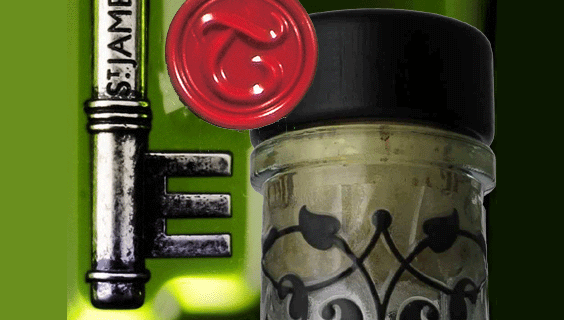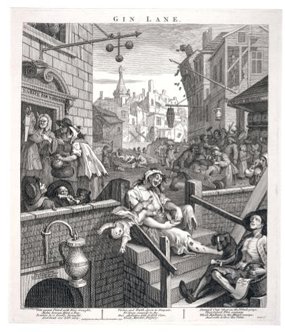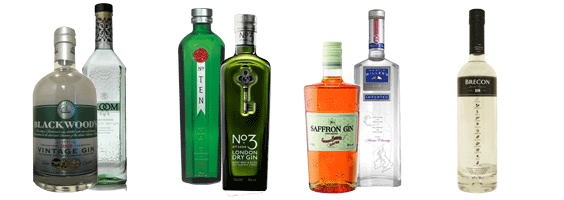Discovering and Understanding Premium Gin

By Paul Howard
Gin has had a chequered history. Italian monks were the first to crudely distill wine into a spirit flavoured with juniper berries to mask the raw taste. Sold for medicinal purposes, it was even tried as a remedy for the Black Death, though without any obvious success.
It is said of gin that that the Dutch invented it, the English refined it but the Americans glamourised it.
In the 17th century Dutch distillers were adding juniper plus various herbs and spices (known as “botanicals”) in a distilled spirit known as genever. In Britain this became popular when a Dutchman, William of Orange, became King and reduced taxes on gin in preference to other spirits.
This resulted in a vast quantity of unlicensed cheap gin that offered oblivion to the urban poor and the Gin Craze was born. Its negative connotations have lasted to this day – notably recorded by William Hogarth in his engraving called Gin Lane, where “drunk for penny and dead drunk for tuppence” defined the image of Mother’s Ruin consumed in intemperate Gin Palaces.
“All gin must contain juniper”
Later, Gin and Tonic would become a signature of the British Empire. Drinking water in India was laced with bitter quinine to help combat malaria. Gin was then added to make it palatable. On their return to Britain it remained the symbo of a declining monied class on which the sun never really set.
Ironically, it is prohibition in the United States that first glamourised gin, a situation that lasted into the sixties. Heralding the Jazz Age and speakeasies, new cocktails embodied the self confidence and decadence of affluent America, and the Dry Martini became its emblem. No cocktail is ever as cool, sophisticated and urbane. It is an essential Hollywood and boardroom accessory. James Bond insists his Dry Martini is shaken, not stirred. I prefer the opposite. Frankly, either will do nicely.
No other drink demonstrates such a polarity of style and fashion as gin and this is reflected in its quality. While all gin must contain juniper, there the similarity ends. At the bottom end, gin is simply a neutral white spirit with some flavourings. It is predominantly juniper and not much else. It is cheap, dull and worth avoiding.
“Strength can reveal complexity”
True Distilled Gin is far superior. Neutral spirit of 96% abv is redistilled in the presence of a range of botanicals. These are either immersed in the liquid itself or suspended in the distilled vapour. The spirit is then cut back with water to at least 37.5% abv. Unlike whisky or brandy, gin is not aged to gain other flavours or tame it. The result is therefore entirely down to the quality of the botanicals and the distillation process. For a distiller it is cash-flow heaven.
While every gin contains juniper, it is the botanicals that make every gin uniquely different. There is a wide range to choose from. For example coriander, liquorice, citrus peels, orris root, cassia bark, angelica and star anise are all common. However, the exact recipe is usually a close secret and not all are declared on the label. Many other botanicals are used, including pricy ingredients such as saffron.
Before buying it is also worth checking the alcohol level. The minimum 37.5% minimises duty and so keeps the price down, a ploy used by some well known brands. The best examples are usually 40% or more. This strength keeps the lighter botanicals from vapourising too easily. Strength can reveal complexity as well as potency.
“Artisan production”
Distilled Gin has a range of sub-styles. London gin has no colourants or sweeteners allowed, so these are clear and very dry. Plymouth gin is only made in Plymouth, as it supplied the Navy. It is stronger, sweeter and earthier in flavour. Other variants include geneva, the heavier and darker dutch gin which is sometimes barrel aged. Old Tom is very sweet and long out of fashion.
Gin went out of fashion the seventies and eighties and its popularity seemed in terminal decline. However, the establishment of bar culture and cocktails in Britain means gin is now restored to eminence as the sophisticated versatile mixer. Distillers have seized upon this opportunity and there are now around 300 different examples available. While basic and mid-price gins continue to struggle as a category, the premium gin sector has exploded, trading on style and the higher quality derived from artisan production. New distillers and brands continue to appear and the established brands, initially caught off-guard, have had to respond.
“Find one that suits your taste”
Gin is vibrant again, but Is there a worthwhile difference in choosing premium gin? You bet, whether you take your gin neat or use it in a cocktail, quality always shows. There has never been a better time to discover the diversity that premium gin can offer. Find one that best suits your own taste. To set you on your way I recently conducted a comparative blind tasting of six premium gins against my usual benchmark gin. Each one being markedly different and with something unique to offer.
As gin is so versatile for mixologists each was presented in three ways. First, drunk neat over ice to explore character, then mixed with tonic as a classic G&T and finally as a Dry Martini (stirred, not shaken, with a hint of vermouth and obligatory olive). Mathematicians will spot this means 21 different drinks, so this wasn’t an activity to be rushed!
A final word before presenting these gins and my findings. If you choose premium gin then please use premium cocktail ingredients to avoid disappointment! Mass market brands of tonic water are gloopily sweet, either from sugar or aspartame, drowning out any subtlety. I used Fever Tree throughout, you could also try Fentimans or Q. For the vermouth needed for a dry martini I waved a bottle of Noilly Prat around, which did the trick. Martini & Rossi or Boissiere work well too. All drinks were served in identical glasses and the ratio of gin to mixers kept constant. Identities were only revealed at the end.












Thx! RT @winealchemy1: Great Gins: @BLOOMGin @Tanquerayusa @berrybrosrudd @PenderynWhisky @MartinMillerGin http://t.co/7yXCWomEvb
Our friend Paul know what he’s talking about when it comes to wine – and now he moves into Gin territory. An… http://t.co/FBKpN7klLZ
Great Gins: @BloomGin @TanquerayUSA @BerryBrosRudd @PenderynWhisky @MartinMillerGin @BlackwoodsGin @GabrielBoudier http://t.co/aE726fQuTo
BEST PREMIUM GINS & History by PAUL HOWARD wine and drink expert http://t.co/ktLdaMCrz0
BEST PREMIUM GINS & History by PAUL HOWARD wine and drink expert http://t.co/u6OM5UVjWQ
Get reading @on_magazine my article on Premium Gin http://t.co/aE726fQuTo